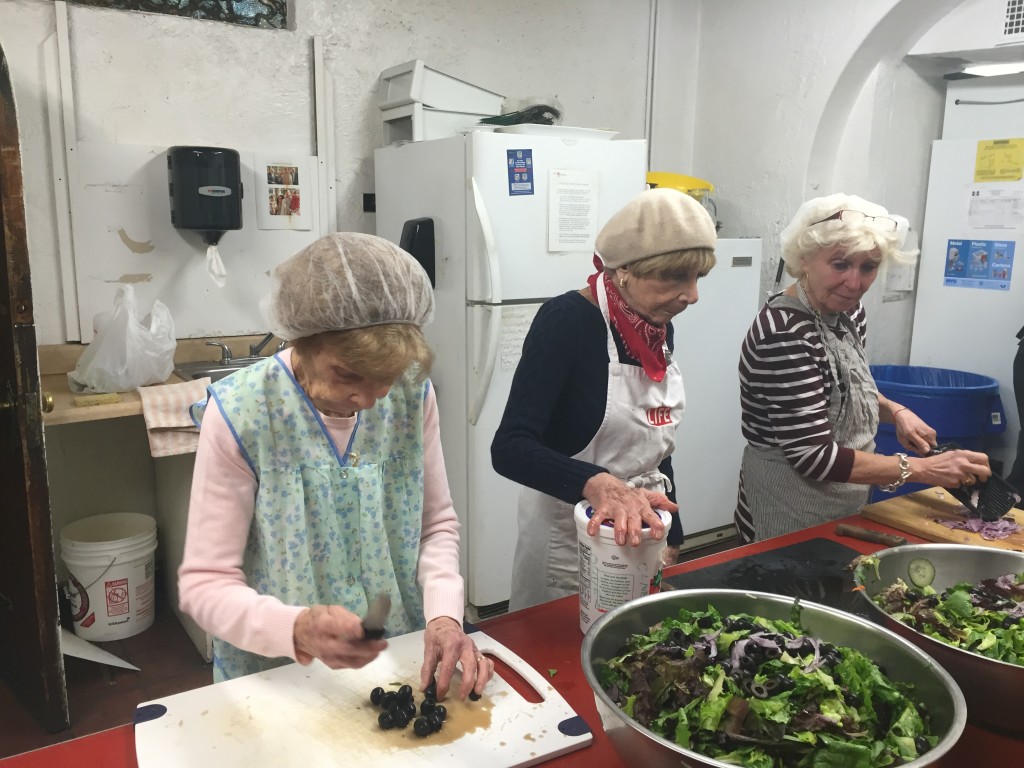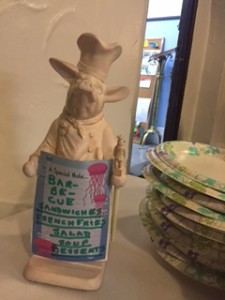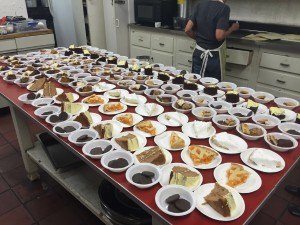Soup kitchen plus dignity equals “an old-fashioned church supper”
By Lindsay Purcell
On a cold Thursday morning in March, three days before Easter, volunteers were hard at work at the historic St. George’s Church on Stuyvesant Square preparing a three-course meal. In the basement, a pink tablecloth covered a long buffet table, which was decorated with baskets of Easter eggs and silverware rolled in festive napkins. From the adjacent kitchen, the pungent smell of chicken potpie filled the air.
At 10:30, guests began to file in, making their way to the silver coffee urns, filling their cups before settling in to read the paper, catch up with each other and wait for lunch. Coming to St. George’s is a weekly ritual for many of the guests, most of whom are homeless and come, not only to get a hot meal, but also to socialize with friends, including the volunteers who serve them.

Volunteers prepare a salad for the Thursday lunch offered at St. George’s Common Table. Photo: Lindsay Purcell.
For over five years, Doug Perry, a retired opera singer who has performed at the Met and La Scala, has overseen the weekly Thursday lunch at St. George’s, which provides a hot meal for around 100 people. “We really consider it a ministry, and we don’t call it a soup kitchen; we call it a common table,” he said. “I just basically consider it like an old-fashioned church supper.” The meal features buttered bread, soup, green salad and an entrée, which is always made from scratch. The highlight of the meal comes at the end, when guests can choose a dessert from a table groaning with options, all made at home by volunteers Perry calls the “dessert ladies.”
Perry said that the common table does not advertise; guests find it through word of mouth on the street. “They joke and say ‘Please don’t tell anyone about this’ because they love the food so much,” he said. Each week Perry plans out the menu himself, often inspired by something he has enjoyed at a dinner party. He orders the food from a purveyor, then cooks the entrees in the church’s tiny kitchen, aided by a loyal core of eight to 10 volunteers. Most of the volunteers come every week, inspired by the gratitude of the guests and the camaraderie of the kitchen. “We have pretty standard things, but because of a generous donor who provides our funding we’ve been able to be pretty adventurous lately,” he explained, adding he has been able to serve chicken, pork loin – even lobster.

The menu of the day is announced at the head of the buffet table. Photo: Lindsay Purcell.
Perry has been the unpaid head of the soup kitchen for five years, welcoming his guests before every meal – and frequently breaking into song. “You will find that the food here is the best, and that it is made with love,” said Cathy Harmon, a retired flight attendant, who focuses her efforts on decorating the buffet table, including displaying the daily menu on a decorative pig sculpture wearing a chef’s hat. “We try to make it nice.”
Back in the kitchen, while the chicken potpie cooked in two small ovens, volunteers gathered around a center island, chopping the ingredients for the green salad. “There’s always a debate as to how to chop the vegetables,” said Lisa Scholtes, a regular whose children attend the church’s preschool. “And the answer is always, ‘How do you do it at home?’ We all have our different styles.” John Neely, the head chef at Crossroads, a large soup kitchen run by St. Bartholomew’s church on Fifth Avenue in midtown, prepared vegetable soup. It was his day off from Crossroads, but he always spends his day off volunteering at St. George’s. “This is a great program that Doug has been doing, the food is excellent,” he said. “I mean, look what he has to work with? Two little stoves and half a refrigerator basically, and that takes a lot of imagination to make that work.”

Guests are invited to choose from an array of dessert options. Photo: Lindsay Purcell.
Once the volunteers finished preparing the salad, they cleared the table and spread the desserts across it, each individually sliced and served on small plates. One “dessert lady” brings in five or six cakes every week; others bring in one or two. The preschool class at the church school also provides dessert once a month. “When the kids bring it they are so excited,” said Perry. “And I could just cry saying this but when I will say to our guests ‘I want you to know the kids made this,’ the guests all applaud.”
At noon, Perry stood before his guests, welcoming them and inviting them to line up at the buffet. After the meal, guests headed to the kitchen, where they selected dessert. Spread across the table in rows, the selection included pies, cakes and cookies, and volunteers offered each guest a dollop of whipped cream from a canister. “They are very fussy – they know which is the biggest one,” said Claire Packman, a longtime volunteer.
As the meal wound down, regular volunteer Chris Attanasio, a former tennis pro and sometime minister who says the weekly grace, circulated among the guests, most of whom he knows by name. He said he volunteers at several soup kitchens across Manhattan, but there is something unique about the Thursday meal at St. George’s. “This is more about the interaction, camaraderie, place to meet – because, you know, when you don’t have a home, you’re always on the move, you’re always outside, it’s not like you bump into someone on the street and say ‘Come over to my place, or I’ll come over to your place’ because you don’t have a place. This is the place,” he said.
Food with a side order of friendship
By Sanaz Rizlenjani
Jose Debourg takes his coffee black. He sits alone, quietly sipping, waiting in the basement of Calvary St. George’s Parish Episcopal Church, across from Stuyvesant Square in downtown Manhattan. This is his regular Thursday spot – he looks forward to it all week.
He likes to get here early, and to sit at a table near the basement entrance. From here, he has a clear view of the station where soup is served, as well as of the front doors, through which hungry guests trickle in for another weekly lunch prepared by church volunteers.
Debourg spent the previous night in Gramercy Park, on the steps of another church, where he has grown accustomed to sleeping on a makeshift bed of cardboard and a sleeping bag. Since the weather started warming up, he says he sleeps there every night, but when it is cold he prefers a subway station to the city’s shelter system.
“Guys get murdered in shelters in New York City,” says Debourg, who turned 66 in March. “A lot of people choose to stay in the streets rather than going to shelters. It’s safer on the street.”
Glancing up from his coffee, Debourg notices a familiar face. “Steve!” he calls out. “This is a friend of mine, this is Steve. He’s a Knicks fan.”
Steve Ellison, 57, a rugged man with a smile as warm and inviting as Debourg’s, sits down beside his friend and the two begin to discuss the previous night’s game between the Los Angeles Lakers and the Utah Jazz, the final game for the Lakers’ Kobe Bryant.
“Sixty? Kobe scored 60?” cries Ellison.
Debourg met Ellison through a mutual friend, and both heard about St. George’s Common Table from others living on the street. While Ellison lives in an apartment in the Bronx, he has attended Thursday lunches at the Common Table for the last two years.
Both men recognize the considerable amount of food assistance available to the homeless in Manhattan, relative to other U.S. cities, but they also agree that the homelessness situation has worsened, with the number of homeless people increased “astronomically,” according to Ellison. And there’s a problem at the intersection of food and shelter assistance that makes a decent meal even more difficult, he says.
“Food stamps don’t allow you to buy hot food,” Ellison explains. And because of pests and insect problems, the city’s shelters do not permit guests to bring groceries or prepared meals inside. Food Emporium near Union Square, he says, is one of the few places that accept food stamps for hot food purchases at the deli.
Ellison, who receives $22.50 in food stamps in addition to his military benefits each month, chooses to cook the majority of his meals himself, at home. He purchases fresh vegetables and put his SNAP benefits toward meats like chicken, sausage, and steak. “It’s a much better deal for me to go to supermarkets in my area, and store and freeze all my steaks, and cook at my leisure.”
Ellison strives to eat a balanced diet and to have three meals each day. He is here today not for himself, but to collect a hot meal for someone who could not attend. Every week, he leaves his Fordham Heights apartment in the Bronx and stops by lunch at St. George’s to grab a plate of food for a friend in Manhattan. “Not everybody has the opportunity to make it to these soup kitchens,” he says.
Debourg frequently visits other Manhattan soup kitchens, and also makes an effort to eat healthy food. Most mornings, he opts for a vegetarian breakfast, served by a Hare Krishna group in Tompkins Square Park in the East Village – salad with fruit, homemade cake, and pasta or rice. On weekends, he attends other soup kitchens, most of them in downtown Manhattan, and treats himself to a full breakfast with eggs, bacon, and sausage. “Weekends I’ll eat a little more,” he says.
According to Debourg, what distinguishes St. George’s is the thoughtfulness and care conveyed by both the food and the people. He will be the first to tell you that it is not a regular soup kitchen.
“Not only do they serve excellent food,” says Debourg, who has been a regular for almost two years. “They cook it with love. And another thing is, they make you feel like family.”
He says that a lot of times New Yorkers “shy away” when interacting with the homeless: “For reasons I can understand, they don’t really connect.”
But here, things are different. Volunteers make a deliberate effort to greet each guest, and to chat and get to know them. While many of the regulars are in need of food and other types of assistance, these lunches are open to anyone who wishes to join, whether they are homeless or not, and everyone is welcome to several helpings, as long as food is available.
After relatives moved away from the city, Debourg struggled with alcohol abuse for about seven years. He says he used to attend AA meetings, and no longer has a problem, but has been living on the street for the past couple of years, off and on. “I appreciate how I’m treated here,” he says, “It helps me feel a little bit better about myself, in spite of the situation.”
As the clock nears noon, the scent of a home-cooked lunch fills the basement, now transformed into a dining hall. On today’s menu is chili with hot dogs, French fries, and various flavors of cake – all started from scratch at around eight that very morning. The two companions are now ready for their mid-day meal.
“I made good friends out here. We develop friendship, we get information, we help each other out.” says Debourg, looking toward at Ellison. “Anybody can open cans,” he adds. But here at St. George’s, “it’s a family atmosphere.”
Tags: Homemade, Manhattan, Soup Kitchen, Stuyvesant Square
Your Comments